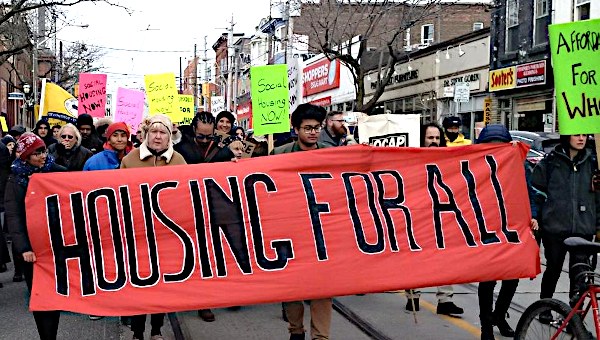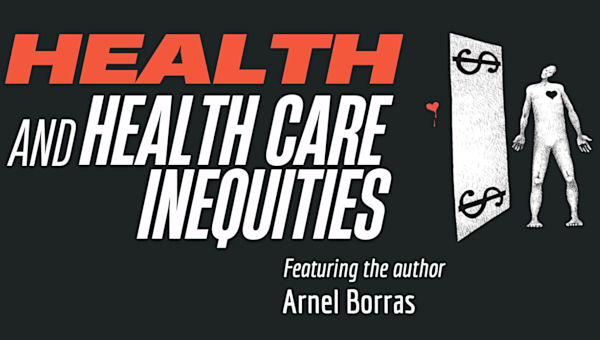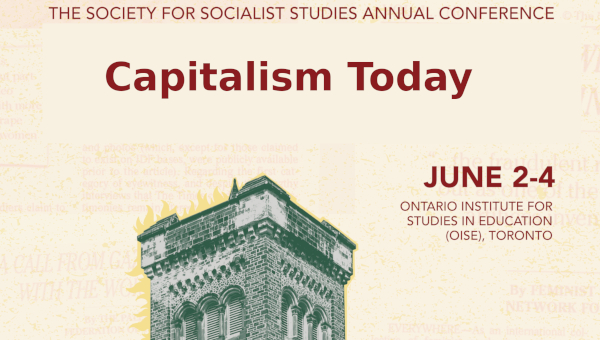Social Commons and the Housing Crisis
The Greater Toronto-Hamilton Area (GTHA) is in the midst of an unprecedented housing crisis. It’s not simply a matter of insufficient supply, but rather a deficit of affordable housing for renters and purchasers.
The Doug Ford government’s document A Place to Grow: Growth plan for the Greater Golden Horseshoe defines affordable housing, whether renting or buying, as accommodation that costs no more than 30 per cent of the gross annual household income for low and moderate households.
Market rate in Burlington, Ontario, is at least $1.3-million for a single detached home, while semi-detached, town homes, and condos are selling for $1-million plus. With a median household income of $101,000 (2019), owning a home is well beyond the means of most individuals and families.
To emphasize just how unaffordable home ownership has become, let’s use the old rule of thumb from the 1990’s – never spend more than three and a half times your annual income when purchasing a home. That would be $353,500 in this case. Median income earners wanting to buy in Burlington won’t qualify for a mortgage on a $1-million dwelling.

Rental Units
Renters fair far worse. Anyone making $19,481 to $48,579 is unable to access Burlington’s primary rental market. Those with an annual income of $72,887 to $146,550 have easy access to rental properties ranging from a bachelor to a three-bedroom unit. But that does not ensure these renters are adequately housed.
In early March, Doug Ford announced that Ontario had its highest number of housing starts in more than 30 years. According to the Canada Mortgage and Housing Corporation (CMHC), there were 100,089 starts in 2021. Ford claimed to have cut the red tape and all of the bureaucracy in order to create affordable housing. He also pledged to build 1.5 million new homes over the next decade. Yet, Ford refuses to acknowledge that increasing the available housing stock doesn’t equate to affordability. That’s because the Conservative government and developers continue to treat housing as a commodity rather than what it is – a human right.
The reality is that the housing crisis in Ontario needs a lot more than just developer-driven increased supply. The provincial government needs to actively build social housing at levels not seen since 1982.
According to Phil Pothen, Ontario Environment Program Manager for Environmental Defence, an average of 20 social houses were built for every 100 market homes in 1982. By 1993, that number had dropped to 14 or 15 per 100 market homes. And, by 2010, less than 2 per cent of new builds were social housing.
A changing economy compounded by the pandemic has dramatically increased housing precarity at the lowest incomes, but it has also impacted moderate and middle incomes. Only an overhaul of the official plan will correct this situation. The plan must include integration of a variety of income levels into all neighbourhoods. This needs to happen for several reasons, not the least of which is to avoid economic segregation.
Neighbourhood mobility offers stability in times of transition. If someone loses their job, they can still find affordable accommodation at a lower price within their existing neighbourhood. If a family needs to move to a larger apartment, they can do this with limited disruption to child care, school, and extra-curricular routines. When seniors down-size, they’re able to stay close to friends and health care providers. Including a wide range of housing options and prices makes these life adjustments more manageable.
Change Legislation
Pothen says that the government can decrease land costs by creating higher density levels simply by including four-to-five story buildings. That effectively lowers construction costs, which means lower prices, and subsequently, lower subsidization costs.
Environmental Defence shared these suggestions with the Ford government. Unfortunately, the government cherry-picked ideas and often undermined progressive ones like requiring commercial space within neighbourhoods. Instead, the Conservative government thwarted walkability by allowing commercial space to be converted to housing.
David Thornley, Policy Advisor to the Social Planning Network of Ontario, participated in a recent panel discussion Housing as a Human Right. Thornley said speeding up the approval process won’t solve the affordability issue. Instead, he suggested using a Social Commons Perspective on housing to look beyond the limitations of current housing policy in Ontario.
A Social Commons Perspective means everyone has access to safe, secure, and affordable housing as a shared collective responsibility. According to Thornley, housing is first and foremost a home, and a place of kinship, family, child development, and caring work. It is also a place to share food and cultural traditions.
Thornley views homes as part of the network of our social relationships and community life supporting the creation and building of community and civil society. They are fundamental to the exercise of local democracy.
Thornley states that unstable, insecure, inaccessible housing contributes to the dismantling of social cohesion and human connection. It worsens physical and mental health, leads to lower educational outcomes, and undermines one’s ability to secure and maintain employment. According to Thornley, the current housing crisis is due to a combination of market failure and a lack of government leadership.
After World War II, the federal and provincial governments recognized that the private market could not meet the housing needs of low- and modest-income renters. For the next four decades, federal housing policy was central to creating a system of social protections.
Between 1963 and 1973, public housing and uncontrolled private rental housing was the focus. From 1973 to 1994, social housing, rent geared to income, and rent controls were emphasized.
Despite recognizing that the private market would never meet the housing needs of low and modest-income renters, the federal and provincial governments withdrew from the housing supply market in 1995.
For the past three decades, these governments have failed to ensure an adequate supply of affordable housing. Then, when the Ford ended rent control, it made an already untenable situation even worse.
Essentially, there is no housing supply problem. The market is doing exactly what it was designed to do – make as much money as possible from those who are willing to pay. Ergo, building housing that meets the needs of all incomes was never part of that plan.
Private Investors
Real Estate Investment Trusts (REITs) are companies that own, operate, or finance income-producing properties. Most REITs are publicly traded like stocks, yet the federal government helps underwrite their mortgages.
REITs own over 20 per cent of the private rental stock in Canada. Studies reviewed by the Association of Community Organizations for Reform Now (ACORN) indicate that if seven of the largest residential REITs had been taxed similarly to non-REIT Canadian corporations since 2010, the result would be an additional $1.2-billion in taxes.
From 2011 to 2016, a total of 320,000 rental units became unaffordable to tenants with incomes under $30,000 annually. Affordable rental units continue to be lost at a rate 15 times faster than new affordable units are being created. REITs and other financial models incentivize taking affordable units off of the market.
Government tax subsidies and mortgage guarantees are rewarding behaviour that drives up housing costs. Instead, that money would be better spent building affordable housing.
Thornley believes it’s time that the real estate industry addressed the lack of transparency within the brokerage industry. Closed bidding unnecessarily drives up prices when real estate agents prey on the emotions and desperation of buyers, especially in the current hyper-heated housing market.
More insidiously, closed bidding lets agents unfairly compete with potential purchasers. Agents are able to out-bid prospective buyers and then flip these same properties at inflated prices. This act is tantamount to insider trading.
As well, absentee ownership and land speculation need to be curtailed. A short-lived Land Speculation tax implemented under the Bill Davis Conservatives collected 20 per cent of the selling price. At the time, housing prices increased an average of 15 to 30 per cent per year, but the tax lowered that to ten per cent for the four years that it was implemented.
Thornley wonders, “Why should private land developers be entitled to all of the unearned appreciation in land and development values resulting from public decisions on future land use?”
He went on to say, “Shouldn’t that windfall accrue to the entire community with only a portion of it going to the people who are developing the property?”
Thornley would like to see at least 50 per cent of the appreciation going to the public to be used for a variety of purposes including building non-profit housing. He also encourages the development of partnerships between governments and credit unions to finance and build affordable rental housing on community land trusts.
There needs to be a radical shift from seeing homes simply as financial entities to viewing them as a space that’s the foundation for community life. Governments need to ensure the creation of livable, local communities offering a range of housing choices and a supply of quality rental units.
The gold standard is still the St. Lawrence neighbourhood in downtown Toronto. Built in the 1970’s, the walkable neighbourhood sits on 44 acres of land acquired in partnership by the city and other levels of government. The 3,500 mixed income housing units made up of five to ten-story buildings and townhomes are within walking distance of St. Lawrence Market, schools, shopping, restaurants, and parks.
Juxtapose that gem with the new Mimico (south Etobicoke) redevelopment on the old Christie bakery site. A mere 28 acres will be home to 7,440 housing units. a density three times greater than that of the St. Lawrence neighbourhood. To achieve this, most buildings will be 25 stories high with ten buildings soaring 40 stories or more.
There is no plan for any social housing. The majority of renters who will occupy the units could never afford to purchase their units. Park and grade-related space is limited to three per cent of the development. Mimico is a ‘community’ designed to maximize profits for the developers and nothing more.
To actually solve the affordable housing crisis, Thornley says that the different levels of government need to implement a variety of solutions using a social commons lens.
For renters, the federal, provincial, and territorial governments need to create 1.5 million social housing units over the next 15 years. They should focus tax subsidies and mortgage guarantees on investors willing and able to maintain the affordability of existing rental stock. Government should also finance the acquisition of 20,000 units over the next 15 years.
Implementing mandatory inclusionary zoning would help increase the number of affordable units available to moderate- to lower-income households.
Government could help first-time buyers by creating starter home ‘Rent-to-Own’ programs focusing on two and three-bedroom homes. Renters would have the ability to buy back 50 per cent of the equity over 15 years.
Funding for increased social housing could, in part, be generated by ending REITs tax breaks and underwriting their mortgages. All that’s needed now is the political will. •
This article first published on the Rabble.ca website.





